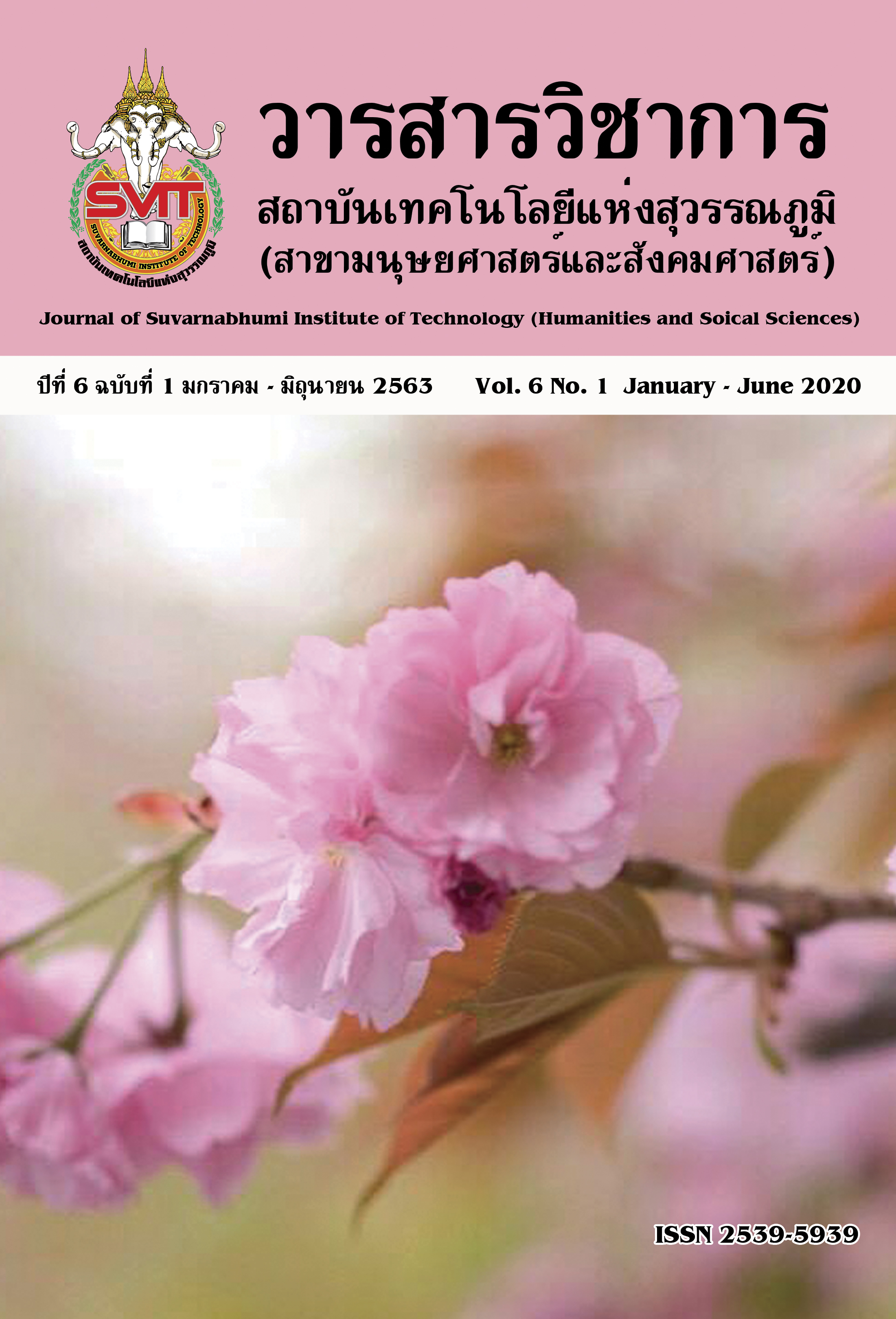CAUSAL RELATIONSHIP MODEL OF CLOTHES REPURCHASING INTENTION ON FACEBOOK LIVE OF THE CONSUMER IN BANGKOK AND ITS PERIMITER
Keywords:
Facebook Live, Repurchasing Intention, Casual Relationship ModelAbstract
The objectives of this research were to developing the casual relationship model of repurchasing intention clothes on Facebook Live of the consumers in Bangkok and its vicinity and examining the consistency of the model with empirical data samples. A sample of 400 individuals was selected from Thai customers who had repurchased clothes via Facebook Live, using convenience sampling method. The online questionnaires composed of the 7 rating scales. The questionnaires contained the query measure gauges for measuring variables included six variables:1) Facebook Live Quality, 2) Trust, 3) Perceived Usefulness, 4) Enjoyment, 5) Subjective Norm and 6) Repurchasing Intention
The findings were as follows: the model is consistent whit the empirical data to a great extent. The statistic shows the Chi-square statistics goodness fit test (c2) = 525.69, degrees of freedom (df) = 383 ,CMIN / DF = 1.37, GFI = 0.92, AGFI = 0.90, SRMR = 0.41, RMSEA = 0.03 and the final is the predictive coefficient of 0.65, So the model could explain the variable repurchasing intention to buying 65 percent with Facebook Live Quality, Trust, Perceived Usefulness, Enjoyment and Subjective Norm which are combined affecting with the Repurchasing Intention to buying products on Facebook Live.
References
กริช แรงสูงเนิน. (2554). การวิเคราะห์ปัจจัยด้วย SPSS AMOS เพื่อการวิจัย. กรุงเทพฯ: ซีเอ็ดยูเคชั่น.
กัลยา วานิชย์บัญชา. (2556). การวิเคราะห์สมการโครงสร้าง (SEM) ด้วย AMOS. กรุงเทพฯ : สามลดา.
ชไมพร กาญจนกิจสกุล. (2555). ระเบียบวิธีวิจัยทางสังคมศาสตร์. ตาก: โพรเจ็คท์ ไฟฟ์-โฟว์.
ฉัตรเฉลิม เกิดสวัสดิ์ และสุมามาลย์ ปานคำ. (2560). รูปแบบความสัมพันธ์เชิงสาเหตุของการยอมรับและการใช้เทคโนโลยีที่มีต่อพฤติกรรมการสื่อสารภายในองค์กรผ่านโซเชียลมีเดียของข้าราชการโรงเรียน
นายร้อยพระจุลจอมเกล้า. 3rd National and International Conference on Education Research and Social Development (NICERSD 2017). 28 เมษายน 2560. 56-62.
นงลักษณ์ วิรัชชัย. (2542). โมเดลลิสเรล สถิติวิเคราะห์สำหรับการวิจัย (พิมพ์ครั้งที่ 3). กรุงเทพฯ: โรงพิมพ์แห่งจุฬาลงกรณ์วิทยาลัย.
นงลักษณ์ วิรัชชัย. (2555ก). การกำหนดขนาดตัวอย่างและสถิติวิเคราะห์ใหม่ ๆ ที่น่าสนใจในการนำเสนอผลงานวิจัยแห่งชาติ 2555.กรุงเทพฯ: สำนักงานคณะกรรมการวิจัยแห่งชาติ.
สำนักงานพัฒนาธุรกรรมทางอิเล็กทรอนิกส์ (องค์การมหาชน) (สพธอ.). (2561). รายงานผลการสำรวจพฤติกรรมผู้ใช้อินเทอร์เน็ตในประเทศไทย ปี 2561. สืบค้นเมื่อ 1 มีนาคม, 2562, จาก https:// www.etda.or.th/publishing-detail/thailand-internet-user-profile-2017.html
สุดาทิพย์ ยอดสายออ. (2559). การยอมรับเทคโนโลยี Facebook Live และความน่าเชื่อถือของข้าวของ Page ที่มีผลต่อการตัดสินใจซื้อเสื้อผ้าบน Facebook. กรุงเทพ: มหาวิทยาลัยกรุงเทพ
Ajzen, I., & Fishbein, M. (1975). A Bayesian analysis of attribution processes. Washington DC: Psychological Bulletin.
Almaghrabi, T. & Ahmed, T. (2010). The Factors Driving Repurchasing Intention to Online Shopping (e-Loyalty): Behaviour differences in the case of Saudi Arabia. United Kingdom: Brunel Business School, Brunel University.
He, Z. L., Kim, Se H. G., & Du H. (2017). The influence of consumer and product haracteristics on intention to repurchase of smart band. International Journal of Asia Digital Art & Design. 21(1), 13-18.
Kongmalai, A. & Distanon, A. (2018). Research Techniques in Technology and Innovation Management. Bangkok: Thamasart University Press. [in Thai]
Morgan, R.M., & Hunt, S.D. (1994). The commitment-trust theory of relationship marketing. Journal of Marketing, 58(3), 20–38.
Selim Aren. (2013). Factors affecting repurchase intention to shop at the same website. United Kingdom: Social and Behavioral Sciences.
Downloads
Published
Issue
Section
License
Copyright (c) 2020 Suvarnabhumi Institute of Technology

This work is licensed under a Creative Commons Attribution-NonCommercial-NoDerivatives 4.0 International License.
บทความที่ได้รับการตีพิมพ์เป็นลิขสิทธิ์ของวารสารวิชาการ สถาบันเทคโนโลยีแห่งสุวรรณภูมิ
ข้อความที่ปรากฏในบทความแต่ละเรื่องในวารสารวิชาการเล่มนี้เป็นความคิดเห็นส่วนตัวของผู้เขียนแต่ละท่านไม่เกี่ยวข้องกับสถาบันเทคโนโลยีแห่งสุวรรณภูมิ และคณาจารย์ท่านอื่นๆในสถาบันฯ แต่อย่างใด ความรับผิดชอบองค์ประกอบทั้งหมดของบทความแต่ละเรื่องเป็นของผู้เขียนแต่ละท่าน หากมีความผิดพลาดใดๆ ผู้เขียนแต่ละท่านจะรับผิดชอบบทความของตนเองแต่ผู้เดียว





